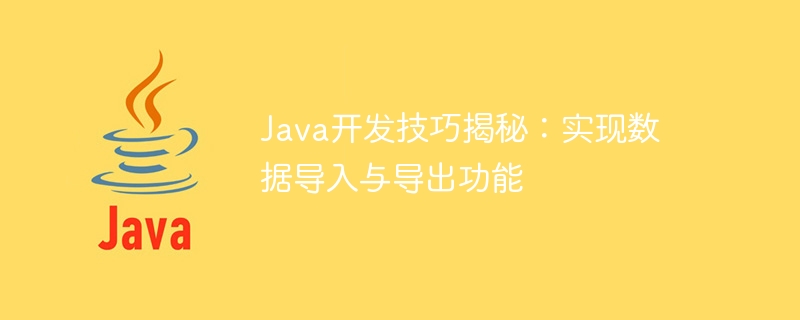
As a popular programming language, Java is widely used in the field of software development. In actual development, data import and export is a common but very important function. This article will reveal some Java development techniques to help developers implement data import and export functions.
1. Implementation of the data import function
Data import refers to the process of importing data from external data sources into the application. Here are some tips for implementing the data import function:
- File type support: First, determine the type of data source to be imported, such as CSV files, Excel files, etc. Depending on the target type, an appropriate Java library or API can be selected to read the file. For example, for CSV files, you can use the OpenCSV library, and for Excel files, you can use the Apache POI library.
- Data verification and processing: The imported data may contain format errors, duplicate data or incomplete data. During the import process, the data needs to be verified and processed. You can use regular expressions to verify the format of your data and create custom validation rules as needed. At the same time, data processing logic can also be implemented, such as removing duplicate data or filling in missing data.
- Import progress monitoring: For large batches of data import, a progress monitoring function needs to be provided. The progress bar can be updated in real time during the import process, or a percentage of the import progress can be given. This way the user can clearly see the progress of the import.
- Exception handling: During the data import process, various abnormal situations may occur, such as file damage, data format errors, etc. In order to improve user experience, these exceptions need to be captured and handled, and corresponding error messages given.
2. Implementation of the data export function
Data export refers to the process of exporting data in the application to an external data source. Here are some tips for implementing the data export function:
- Data filtering and sorting: Before exporting data, the data needs to be filtered and sorted. You can take advantage of the sorting capabilities of Java collections, or use a custom sorting algorithm to meet your specific export needs. In addition, the data can be filtered according to different conditions and only the data that meets the conditions will be exported.
- File format selection: Similar to data import, the exported data also needs to select an appropriate file format, such as CSV, Excel, XML, etc. Depending on the target format, select the corresponding Java library or API to export data.
- Export file naming and path settings: During the export process, you can set the file name and path for the exported file. You can use the current timestamp or other specific identifier as the file name to ensure the uniqueness of the file name. At the same time, a setting option that can customize the path can also be provided, allowing users to decide the storage location of the exported files.
- Export progress monitoring: For the export of large amounts of data, a progress monitoring function also needs to be provided. The progress bar can be updated in real time during the export process, or a percentage of the export progress can be given. In this way, users can clearly understand the progress of the export during the export process.
- Security of exported data: During the data export process, the security of the data needs to be ensured. Permission control can be provided to allow only authorized users to export data. At the same time, the exported data can also be encrypted to avoid the risk of data leakage.
Summary:
Data import and export are common and important functions in Java development. By rationally selecting Java libraries and APIs and combining them with actual needs, data import and export functions can be easily implemented. During the implementation process, it is also necessary to pay attention to details such as data verification and processing, exception handling, and progress monitoring to improve user experience and data security.
For Java developers, it is very important to master the skills of data import and export, which can help them process data more efficiently and provide a better user experience. I hope the content of this article can provide you with some help and guidance in implementing the data import and export functions.
The above is the detailed content of Java development skills revealed: implementing data import and export functions. For more information, please follow other related articles on the PHP Chinese website!






